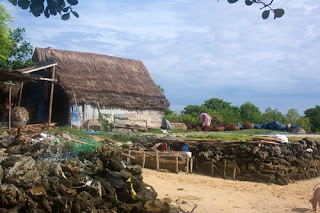Seaweed farming in Halmahera, Indonesia
In the lagoons of the Goraici region off the island of Halmahera in northern Indonesia, a small village has set aside many acres of shallow protected waters to farm seaweed. Seaweeds have many uses, including food, and are harvested for extracts including alginate, agar and carrageenan – all gelatinous substances which are commercially important as food additives and also used in the pharmaceutical industry.
The farming method is very simple. Local Indonesians set up long monofilmaent lines for the seaweed to grow on. Each line is roughly 50 metres long mounted on sturdy poles at each end. Seedlings are attached to the lines, which are suspended by attaching buoyant plastic bottles at intervals along the line. Navigating between the lanes in their small hand-carved boats, the farmers dive down and collect the seaweed that has fallen off the line and is now resting on the sandy bottom.
Seaweed farming provides a very sustainable source of food and income for these communities and is a viable alternative livelihood for coastal fisherman, who might have otherwise resort to destructive fishing practices such as cyanide or dynamite fishing. There is still some environmental impact however, as many farmers cut down mangrove trees to use as support structures for the lines.












